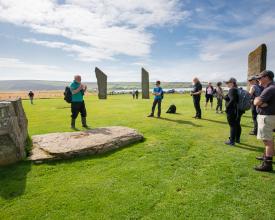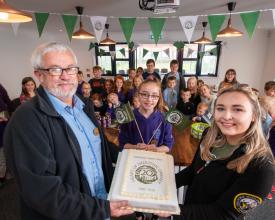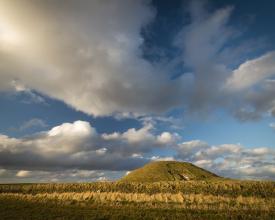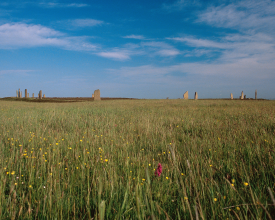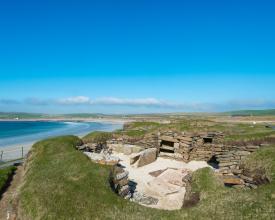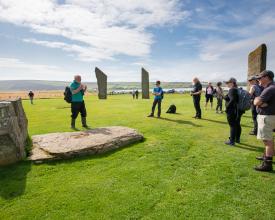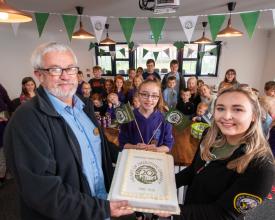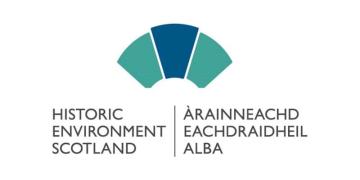
Renforcer la participation de la communauté et des parties prenantes à la gestion et à la conservation du cœur des Orcades néolithiques et de son paysage élargi
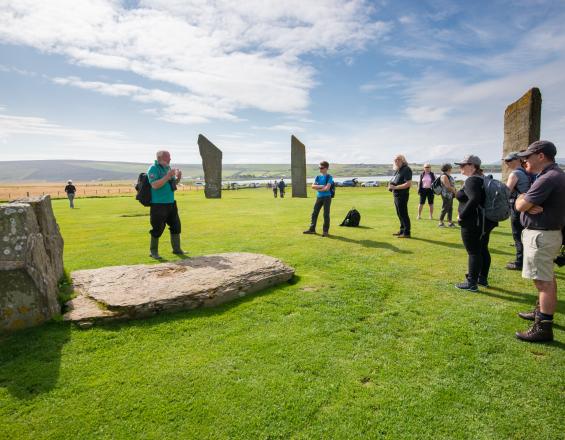
La solution se concentre sur les modalités de gestion du site du patrimoine mondial du cœur des Orcades néolithiques et sur la reconnaissance de la nécessité de renforcer l'engagement de la communauté et des parties prenantes. Le site joue un rôle important dans la formation de l'identité des Orcadiens et, au fil des ans, il est devenu un élément majeur du soutien à l'économie locale de l'archipel en tant que moteur essentiel du tourisme dans les Orcades. La protection des caractéristiques naturelles et culturelles du lieu et son rôle dans le développement du tourisme et des opportunités commerciales sur l'île ont nécessité une coopération entre les agences, le gouvernement local et les organisations caritatives, ainsi qu'une plus grande implication des communautés et des entreprises locales dans le développement d'une stratégie de gestion efficace pour la conservation des Orcades. Les principaux acteurs de ces solutions sont Historic Environment Scotland, Orkney Islands Council, NatureScot (anciennement SNH), la Royal Society for the Protection of Birds et Highlands and Islands Enterprise.
Contexte
Défis à relever
- Défis environnementaux: le problème éventuel de la dégradation du site due aux impacts du tourisme, en particulier lorsqu'il est associé aux impacts du changement climatique, ainsi que la nécessité d'assurer la protection du paysage environnant qui soutient la valeur universelle exceptionnelle du cœur des Orcades néolithiques.
- Défis culturels et sociaux: manque de consultation et d'engagement de la communauté dans la prise de décision concernant la gestion du patrimoine mondial ; manque de compréhension / d'inclusion par les décideurs des valeurs de la communauté en relation avec le statut de patrimoine mondial et la valeur universelle exceptionnelle du bien.
- Défis économiques: nécessité d'améliorer et de renforcer la " répartition de la charge " grâce à la connectivité du tourisme local avec d'autres sites culturels et naturels, à la fois pour réduire la pression de pointe sur les monuments du site du patrimoine mondial et pour assurer et renforcer les avantages communautaires plus larges pour les communautés, les parties prenantes et les entreprises des Orcades, y compris celles qui ne sont pas à proximité immédiate des éléments du bien du patrimoine mondial.
Emplacement
Traiter
Résumé du processus
Cette solution met en évidence le renforcement de la coopération et de l'engagement communautaire nécessaire pour assurer la protection du site du patrimoine mondial du cœur des Orcades néolithiques et le bien-être de ses communautés et de ses parties prenantes.
Le site est géré par un groupe de pilotage conjoint du site du patrimoine mondial. En outre, un partenariat stratégique a été mis en place afin d'améliorer l'expérience des touristes et d'en faire bénéficier la population locale. Ce partenariat prévoit l'utilisation d'investissements pour développer une expérience touristique plus diversifiée et plus complète, atteignant des sites et des lieux qui ne sont pas immédiatement liés au site. Le tourisme sur le site étant à la fois une bénédiction et un fardeau, une vaste campagne de consultation a été menée pour mieux comprendre les perceptions de la communauté locale et des entreprises en ce qui concerne le statut de patrimoine mondial et les valeurs touristiques et autres du site. Les informations recueillies feront partie intégrante des connaissances et des informations utilisées pour la préparation du nouveau plan de gestion du site du patrimoine mondial et la poursuite du développement du partenariat de gestion. Les communautés jouent un rôle essentiel dans la conservation du site, à la fois par la bonne volonté et la gestion communautaire, mais aussi par leur participation directe en tant que gardes forestiers.
Blocs de construction
Groupe de pilotage du site du patrimoine mondial du cœur des Orcades néolithiques
Le bien du patrimoine mondial du cœur des Orcades néolithiques est géré par un groupe de pilotage intégré et conjoint composé de représentants de Historic Environment Scotland (HES), Orkney Islands Council (OIC ), Highlands and Islands Enterprise (HIE), Orkney College University of the Highlands and Islands (UHI) Archaeology Institute, NatureScot (anciennement Scottish Natural Heritage - SNH), et de la Royal Society for the Protection of Birds (RSPB). HES gère les monuments individuels qui composent le WHS, tandis que les autres partenaires sont impliqués dans la gestion plus large du WHS et de la zone tampon de diverses manières. Un coordinateur du patrimoine mondial assure une liaison efficace entre les partenaires et fait avancer la mise en œuvre, le suivi et la révision du plan de gestion et du plan d'action associé, promeut la valeur universelle exceptionnelle et l'intérêt public du patrimoine mondial, accroît la sensibilisation et la compréhension parmi les partenaires, les parties prenantes et le public, et sert de point central pour les conseils.
En outre, le groupe de pilotage est également chargé d'assurer la protection des relations et des liens entre les monuments et le paysage au sens large. Les zones entre les monuments qui composent le bien du patrimoine mondial et celles de la zone extérieure qui soutiennent la valeur universelle exceptionnelle sont potentiellement menacées par le changement et le développement dans la campagne.
Facteurs favorables
Les compétences intégrées nature-culture du groupe de pilotage, grâce à sa coopération multidisciplinaire entre les partenaires de gestion, sont nécessaires à la protection des valeurs culturelles et naturelles du cœur des Orcades néolithiques.
Leçon apprise
- L'expérience du cycle précédent du plan de gestion et la coopération entre les acteurs institutionnels multidisciplinaires ont mis en évidence la nécessité d'un changement d'orientation dans le plan de gestion révisé, qui s'appuie fortement sur les relations entre le bien du patrimoine mondial du Cœur des Orcades néolithiques et le paysage terrestre et marin plus large de l'archipel.
- L'approche de gestion intégrée est essentielle à la protection du bien du patrimoine mondial du cœur des Orcades néolithiques et de sa valeur universelle exceptionnelle, en particulier lorsqu'il s'agit d'infrastructures et d'autres propositions de développement (par exemple, les propositions passées de construction d'éoliennes et d'installations connexes).
- La gestion du bien du patrimoine mondial du Cœur des Orcades néolithiques doit être intégrée dans une planification locale et nationale plus large, en tenant compte non seulement du site lui-même mais aussi du cadre plus large du bien et de son paysage environnant.
Partenariat pour l'amélioration de l'expérience des visiteurs pour les touristes et au bénéfice des populations locales
Le tourisme est une industrie clé pour l'économie et une source d'emploi pour les communautés locales et les entreprises des Orcades, et contribue donc à la durabilité à long terme de ces communautés et de ces entreprises. Le site du patrimoine mondial et plus largement les Orcades étant confrontés à des défis majeurs, tels que le changement climatique et l'impact du tourisme de masse en période de pointe, un partenariat formel entre les principales agences nationales et locales a été mis en place pour relever ces défis et saisir les opportunités offertes par le tourisme. Ce partenariat réunit le HES, l'OIC et le HIE, et se concentre notamment sur le site du cœur des Orcades néolithiques. Il vise à garantir une expérience durable et améliorée pour les touristes et à optimiser les avantages pour la population locale.
Le partenariat prévoit le développement d'opportunités touristiques différentes, plus inclusives et durables pour les Orcades, en lien avec le plan de gestion du site. Un investissement initial de plus de 300 000 £ aux Stones of Stenness permettra de moderniser les parkings et d'améliorer le réseau de sentiers afin d'encourager une plus grande connexion entre les monuments et les zones naturelles et culturelles environnantes.
Facteurs favorables
Le partenariat de la stratégie Gateway est établi sur la base d'un protocole d'accord partagé signé le 11 juin 2019 par Historic Environment Scotland (HES), Orkney Islands Council (OIC) et Highlands and Islands Enterprise (HIE).
Leçon apprise
- Des fonds supplémentaires seront alloués au développement du voyage des visiteurs et à l'exploration des possibilités d'une plus grande connectivité et d'une amélioration de la façon dont les visiteurs découvrent plus de 5 000 ans d'histoire.
- L'industrie du tourisme est vitale pour la durabilité des moyens de subsistance dans les Orcades. Les visiteurs ne viennent pas seulement aux Orcades pour visiter le site du patrimoine mondial du cœur des Orcades néolithiques et il est possible de renforcer le réseau de lieux naturels et culturels et les possibilités offertes aux visiteurs de partager les bénéfices et les revenus liés au tourisme entre les multiples entreprises et communautés.
- À l'heure actuelle, compte tenu des limites de la pandémie de grippe Covid-19, il est difficile de quantifier davantage l'impact de ces efforts puisque le site des Orcades a été fermé pendant une grande partie de la saison estivale 2020 et que l'accès à l'Écosse est toujours limité à un certain nombre de nationalités. Toutefois, cette "pause" imprévue a permis aux partenaires de réfléchir davantage à la manière de relever ces défis.
Service des gardes forestiers
Le cœur des Orcades néolithiques est d'une grande importance pour l'identité locale des Orcadiens et la gestion et l'engagement locaux sont essentiels pour assurer une gestion adéquate et efficace du site et de son cadre paysager plus large. Depuis 2005, un service de gardes forestiers a été mis en place pour servir à la fois les visiteurs des sites et les membres de la communauté locale et les résidents. Des postes de gardes saisonniers ont été ajoutés et des postes de gardes volontaires ont été pourvus par des résidents locaux qui travaillent aux côtés des gardes du site du patrimoine mondial employés par Historic Environment Scotland.
Les gardes bénévoles jouent un rôle important dans la protection du patrimoine naturel et culturel des Orcades en participant aux patrouilles à pied, à la supervision des événements organisés par des tiers, aux promenades guidées et au soutien des groupes scolaires et communautaires. Ils sont en première ligne dans l'engagement avec le public et s'engagent activement à assurer un accès sûr et responsable au site et à son appréciation.
Des services de gardes forestiers ont été mis en place dans un certain nombre de propriétés gérées par Historic Environment Scotland afin d'encourager la bonne volonté, le sentiment de responsabilité et l'intendance des communautés locales et des parties prenantes.
Facteurs favorables
Le programme de volontariat est organisé par Historic Environment Scotland et soutenu par le mentorat des rangers travaillant sur le site. Les rangers volontaires reçoivent un uniforme de rangers et toutes les informations nécessaires pour accueillir et guider les visiteurs sur le site. Au fil du temps, les bénévoles sont devenus des rangers saisonniers employés.
Leçon apprise
- Les gardes forestiers jouent un rôle clé dans la qualité de l'expérience des visiteurs. Ils donnent vie à l'histoire et aux sites pour les milliers de visiteurs qui viennent aux Orcades chaque année. Ils organisent des promenades en journée et des visites en soirée, ainsi que des visites spéciales pour les écoles et les groupes communautaires. En outre, les rangers participent à la création de nouvelles opportunités et activités pour les personnes qui visitent le site tout au long de l'année et dans de multiples conditions météorologiques.
- Le rôle des rangers est d'assurer l'équilibre entre la conservation du site et l'expérience des visiteurs, en particulier sur les sites les plus fragiles comme l'anneau de Brodgar et les pierres de Stenness.
- Le programme des gardes forestiers est une opportunité de développement des capacités car il permet d'améliorer et de renforcer les compétences professionnelles et personnelles.
Consultation de la communauté et des parties prenantes locales pour le plan de gestion du cœur des Orcades néolithiques
Le cœur des Orcades néolithiques joue un rôle important dans l'identité locale et dans la durabilité de l'économie et des entreprises touristiques locales.
Dans le cadre du processus d'élaboration d'un nouveau plan de gestion, les communautés locales, les résidents et les entreprises ont été invités à exprimer leur point de vue sur la gestion future du cœur des Orcades néolithiques. Au début de l'année 2020, une campagne de consultation a été menée à l'aide de méthodes quantitatives et qualitatives comprenant une enquête (en ligne et sur papier) et une série de trois séances de consultation qui ont eu lieu au Centre St Magnus, à Kirkwall, au Centre des visiteurs de Maeshowe, à Stenness et au Centre communautaire Milestone, à Dounby. D'autres consultations et réunions ont eu lieu avec des organisations communautaires locales.
La consultation s'est attachée à comprendre la valeur du cœur des Orcades néolithiques ainsi que le rôle joué par la désignation au patrimoine mondial pour les communautés et les entreprises locales. La consultation a également porté sur la manière d'améliorer la communication avec les parties prenantes locales et a abordé la question de leurs principales priorités pour l'avenir du site.
Facteurs favorables
L'exercice d'engagement communautaire a été mis en œuvre par un consultant indépendant mandaté par le groupe de pilotage. La consultation a impliqué 95 personnes et organisations, dont des élèves d'écoles primaires et secondaires, des entreprises, des résidents et des personnes représentant divers groupes et organisations communautaires (par exemple, des agriculteurs et des propriétaires terriens, des passionnés d'histoire et de patrimoine).
Leçon apprise
L'engagement de la communauté a révélé des informations importantes et des perceptions de la communauté qui sont essentielles pour la préparation du nouveau plan de gestion pour le cœur des Orcades néolithiques :
- Le statut de patrimoine mondial est important pour attirer le tourisme dans les Orcades, mais il peut aussi être une limitation car son interprétation ciblée ne permet pas d'aborder l'histoire plus large des Orcades.
- Une approche plus large et plus cohérente du tourisme, impliquant également les sites non inscrits au patrimoine mondial, permettrait d'éviter les goulets d'étranglement pendant les mois de pointe.
- L'attrait touristique des Orcades ne provient pas seulement du statut de patrimoine mondial de certains de ses sites, mais aussi de l'éventail plus large de sites du patrimoine culturel et naturel, ainsi que des produits locaux (viande bovine, industrie ovine, whisky, produits de marque locaux), qui constituent un aspect essentiel pour les entreprises locales et leur viabilité.
- Les habitants ont exprimé leur attachement à l'histoire des Orcades et de leurs habitants, et leur désir de voir cette histoire pleinement représentée et connectée afin de la partager avec le monde.
- Il est nécessaire d'améliorer les installations communautaires qui se sont détériorées au fil du temps, et le tourisme pourrait servir de catalyseur pour financer la rénovation et l'amélioration de ces installations.
Impacts
- Culturel et social : l'approche établie pour la gestion du site et le développement futur des opportunités touristiques a identifié le paysage au sens large comme ayant une grande importance pour la protection de la valeur universelle exceptionnelle du cœur des Orcades néolithiques.
- Culturel et social: la solution identifie l'importance des communautés locales, des parties prenantes et des entreprises dans la gestion et la conservation du site. Le cœur des Orcades néolithiques est important pour la communauté locale, non seulement en raison de son statut de patrimoine mondial, mais aussi de son rôle en tant qu'élément clé de l'identité culturelle orcadienne ; les communautés sont disposées à s'engager dans le site et sa gestion et souhaitent participer à un dialogue, et pas seulement recevoir des informations. Le renforcement des canaux de communication entre la gestion du site et les parties prenantes et communautés locales est bénéfique pour la gestion du site et la compréhension de sa (ses) valeur(s) de part et d'autre ;
- Le tourisme : le tourisme est une industrie clé pour les habitants des Orcades. La gestion durable du tourisme nécessite une approche plus large du paysage pour inclure les sites qui ne sont pas inclus dans le statut de patrimoine mondial, ainsi que des zones d'intérêt naturel et culturel plus vastes.
Bénéficiaires
Les bénéficiaires de cette solution sont les communautés et les entreprises locales des Orcades. La solution se concentre sur le renforcement de la participation et sur la recherche d'opportunités touristiques plus cohérentes et plus durables pour les Orcades.
Histoire
La garde forestière Sandra Miller passe plus de temps que la plupart des gens à apprécier le paysage du cœur des Orcades néolithiques. Avec une attention particulière pour l'anneau de Brodgar et les pierres de Stenness, elle et l'équipe de gardes forestiers passent beaucoup de temps à rencontrer des gens du monde entier venus voir les sites étonnants que les Orcades ont à offrir. Au quotidien, ils assurent une interprétation directe du paysage naturel et historique de cette région emblématique.
Pour Sandra, passer du temps avec les visiteurs et les habitants est l'un des aspects les plus agréables de son travail, car cela lui rappelle chaque jour à quel point ces monuments sont spéciaux. Le grand nombre de visiteurs et la facilité d'accès posent toujours le problème de la protection des sites. Sachant que les gens veulent vivre la meilleure expérience possible et voir le plus de choses possible, il s'agit de trouver le bon équilibre. Sandra et l'équipe font constamment évoluer leurs idées et leur réflexion pour garantir une excellente expérience aux visiteurs, tout en veillant à ce que l'archéologie et le paysage naturel soient également protégés. Pour Sandra, il est essentiel que les jeunes des Orcades comprennent le caractère unique des sites et du paysage environnant. Les visites d'écoles constituent donc une part importante du travail, que tous les rangers apprécient, car ils ont tous le sentiment de protéger le site non seulement pour aujourd'hui, mais aussi pour les générations futures.
